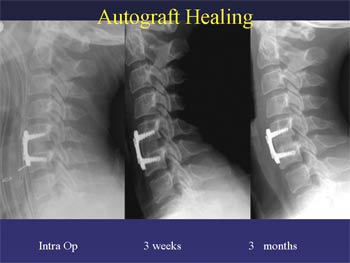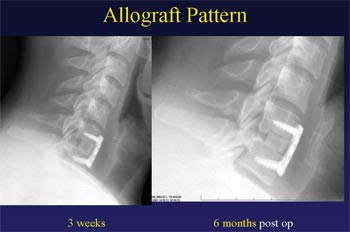Surgeons debate best graft option for anterior discectomy and fusion
Experts said donor site morbidity and disease transmission are among the top concerns.
CHICAGO – The optimal choice for anterior cervical grafts in anterior discectomy and fusion is an ongoing debate among spine surgeons. Autograft, allograft and bone graft substitutes with rhBMP, each offer advantages and disadvantages, but a lack of Level 1 data leaves surgeons to their own preferences.
While autografts offer a higher fusion rate, there is still evidence of donor site morbidity, admits James D. Kang, MD, an autograft proponent at the University of Pittsburgh School of Medicine.
However, he is quick to point out that, although allografts eliminate the risk of donor site morbidity, they raise the potential issue of disease transmission. Substitutes overcome these risks but require further investigation.
Kang, along with Jeffrey S. Fischgrund, MD, of the William Beaumont Hospital in Royal Oak, Mich., and Jeffrey C. Wang, MD, of the UCLA School of Medicine in Los Angeles, debated the issue at the Federation of Spine Associations Specialty Day Meeting.
Higher fusion rates
Before surgeons routinely used anterior plates with allograft, orthopedic researchers reported on the superiority of autograft over allograft in fusion time, fusion rate and nonunion rate, Kang said. Surgeons found an average 8% nonunion rate with autografts, while allografts had a 35% to 38% delayed union rate at three months, and then a 20% nonunion rate at one year.
Investigators also found a 95% healing rate for both autograft and allograft in single-level anterior cervical discectomy and fusion (ACDF), Kang said. However, that number declined with multi-level ACDFs.
Courtesy of James D. Kang |
“The anterior plating came of age, and I think it helped us surgeons tremendously. There’s no doubt it improved our fusion rate,” Kang said.
However, studies have shown the fusion rate with allografts and a plate are still 5% to 6% less than the fusion rates for autograft, Kang said. In addition, healing rates for allografts with anterior plates are still lower than autograft healing rates.
In a study by Suchomel et al published in 2004 in the European Spine Journal, 95% of patients with autografts achieved fusion within six months, while patients treated with allografts and plates took a year to reach a 95% fusion rate, Kang said.
Fischgrund argued that allograft with plates typically performs better than autograft for multi-level ACDFs.
Even studies without anterior plates, such as the one by Zbedlick et al in Spine (1991), revealed comparable fusion rates for autograft and allograft at one-level ACDF, he said. At two-level ACDF, autograft fusion rates dropped to 37%, while allograft only dropped to 83%.
Fischgrund cited another study, this one by Wai-Mun et al in Spine (2005), who evaluated 71 patients with 134 spaces treated with ACDF using a fibula ring allograft and an anterior plate. Those patients with one-level fusion achieved a 96% fusion rate by the 7.2-year follow-up. Eighteen percent of patients experienced partial subsidence and 30% of those with multi-level surgery had partial collapse. But researchers found no reoperations.
“There will be subsidence, there will be a little bit of a collapse, but … it’s really not all that significant,” Fischgrund said.
In spite of the high fusion rates with autograft, some surgeons are concerned with autografts causing donor site morbidity.
A review of Kang’s database revealed 1600 ACDF patients with iliac crest bone graft harvest. Five percent to 10% of those patients experienced moderate discomfort. Although this was a low number of patients with pain, Fischgrund said it is not acceptable for a “gold standard.”
“Our goals as surgeons are to get the patients back to their normal life as soon as possible,” he said. “I think if we use allograft, we’re more likely to achieve that goal.”
Fischgrund presented autograft studies that found moderate to high chronic pain rates. A study by DePalma found 36% of patients with persistent pain, and a study by Schnee found an 11% rate.
In contrast to autografts, allografts are in greater supply, they reduce operating room time and reduce morbidity, Fischgrund said. However, he admits that disease transmission is an issue because of poor donor monitoring at some tissue banks.
Allograft precautions
From 1994 to 2005, officials recalled 19,591 allograft tissues from 63 domestic donor banks, Wang said. Of these, 85.6% were recalled for suboptimal donor evaluation or abnormal serological tests of HIV or hepatitis.
From 1997 to 2003, hospitals reported 27 cases of bacterial transmission in allograft tissue, and Wang believes this number is conservative because the condition is often underreported.
“What you really have to check is, where are you getting your graft from, is this an accredited institution and are they doing things right?” Fischgrund said.
The American Association of Tissue Banks accredits institutions to ensure they maintain standards for graft retrieval, preservation and distribution.
“It really comes down to, are the tissue banks doing the right job?” Fischgrund said. “The federal response was made in 2005 with specific standards for storage, recordkeeping and reporting. And we urge you to make sure that the tissue bank where you’re getting your products from is complying with all of these [standards].”
Courtesy of James D. Kang |
Substitutes are just as good
Wang said he does not use autograft because of the pseudoarthrosis rate, persistent pain and potential for multi-level defects. However, he does use allograft because of its reasonable fusion rates.
“But there is a limited supply,” he added. “There are limited sizes … there’s donor variability and there are disadvantages. You cannot sterilize allograft. [Therefore], there is a risk of contamination and disease transmission.”
Substitutes, on the other hand, do not risk donor site morbidity and are widely available in different sizes and shapes to fit the patient, he said. In addition, researchers who used graft material inside cage devices showed successful fusion rates, Wang added.
Thalgott et al in Spine (1999) found a 100% success rate with coralline hydroxyapatite, and McConnell et al in Spine (2003) found that 89% of grafts were fragmented, using coralline-derived hydroxyapatite.
Several studies have also shown that results of ACDFs with cages are comparable to autograft results: Salame et al in Neurosurg Focus (2002) found 93% to 98% fusion rates, and Ryu et al in the European Spine Journal (2005) found 100% fusion rates with iliac crest bone graft vs. cages.
“There is a large number of studies out there that support the use of cages,” Wang said. “Substitutes are a reasonable option, and I think it’s because the cervical spine is a robust environment.”
Researchers who added rhBMP to the graft substitute demonstrated even higher fusion rates, Wang said. For example, the study by Baskin et al in Spine (2003) was one of the first prospective, randomized trials of rhBMP use in the cervical spine, Wang said. Researchers found a 100% fusion rate with iliac crest bone graft and rhBMP at three months.
Wang believes that, in the future, spine surgeons will use rhBMP combined with a resorbable cage or synthetic cage, but the proper dosage of recombinant human bone morphogenetic protein-2 must be established.
He added: “If [substitutes] are the future, [there will be] no disease transmission, hopefully no contamination, you can sterilize … and if you’re using rhBMP, you get a very high fusion rate, [an] early time to fusion, which hopefully will save in the overall costs, and hopefully no second surgery [or] donor site morbidity.”
No matter what surgeons use though, Kang said, the vast majority of patients will perform well. The surgeon’s decision is typically based on “the tolerance of what you’re willing to accept – whether you’re going to accept more nonunions or accept a few more patients with iliac crest bone graft site pain,” he said. New biologic [agents] we will need to investigate carefully.”
For more information:
- Kang J. Autograft remains the best choice. #2.
- Fischgrund J. Allograft has become the gold standard. #3.
- Wang J. You’re both wrong – Substitutes are here and just as good. #4. All presented at the Federation of Spine Associations Specialty Day Meeting. March 25, 2006. Chicago.


